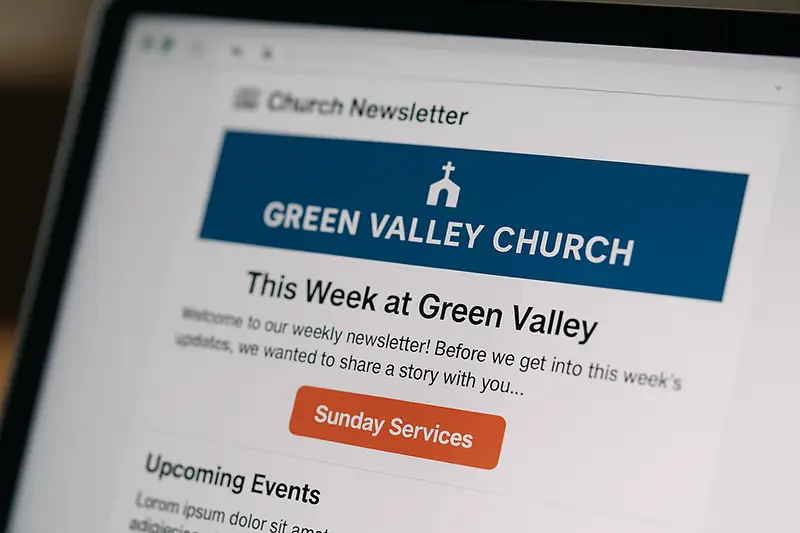
Newsletters get ignored when they read like bulletin boards, say too much to too many people, or get sent sporadically without clear purpose. Transforming them requires shifting from information dumps to storytelling, segmenting audiences so people receive relevant content, and simplifying formats so messages are skimmable and actionable. Making newsletters conversational, two-way, and focused on connection rather than coverage turns ignored emails into powerful tools for engagement.
What to Do When No One Reads Your Church Newsletter (And How to Fix It)
You spend an hour crafting it. You proofread it three times. You format the links, add a catchy subject line, even throw in an emoji. And then?
Crickets.
No one opens your church newsletter. Or if they do, they skim the first line and archive it faster than you can say “Please scroll down.”
We’ve been there.
But before you swear off email forever (or start writing in all caps out of spite), take heart: there’s hope. And it doesn’t require a total overhaul...just a few strategic shifts.
Let's talk about why your emails aren't landing… and how to turn them into something people actually want to read.
Key Takeaways
- Change the format from bulletin board to storytelling—start with a story or real moment that feels human, lead with connection not just information, make the first 2-3 lines shareable
- Segment like a shepherd—stop sending everything to everyone, use filters for parents, guests, attenders, volunteers, send relevant info not all info
- Simplify and skimmify—people skim, so use big headlines, short paragraphs (2-3 lines max), clear CTAs, 2-3 quick links with bullets, spacing and bold text
- Send less, say more—quality beats frequency: one strong weekly email, one monthly ministry-specific update, occasional one-off campaigns
- Make it a two-way street—add polls, ask questions, invite stories, build relationship not just send information, treat it like a conversation not a checklist
First: Let's Acknowledge the Pain
If your church newsletter feels like a waste of time, it might be because:
- It’s trying to say too much to too many people
- It sounds like a bulletin, not a human
- It gets sent sporadically...or 5 times a week (no in-between)
- It reads more like a reminder board than a message worth reading
And maybe, just maybe… your people have been trained to ignore it.
But we can untrain them.
Step 1: Change the Format (From Bulletin Board to Storytelling)
People don’t need another list of “What’s Happening at Church.”
They need a reason to care.
Start your email with a story, a real moment, or something that feels human. Learn how churches can use storytelling to increase engagement:
✉️ “Before we dive into this week’s updates… did you hear about Mark from the 9AM service? He’s been serving in the parking lot for 12 years and just got baptized last weekend. The whole team cried. That’s what community looks like.”
Then pivot to your content. Lead with connection, not just information.
📌 Pro Tip: Make the first 2–3 lines of your email feel like something someone would share. That’s how you build open-rate trust.
Step 2: Segment Like a Shepherd
Stop sending everything to everyone.
Your high school parents don’t need details about the men’s retreat.
Your seniors probably don’t need reminders about the youth lock-in.
Your visitors definitely don’t want “Board Meeting Agenda: Q2 Edition.”
Use your email tool to segment your audience by interests, ministries, or demographics. Even basic filters can help:
- Parents of kids or students
- First-time guests
- Regular attenders
- Volunteers
Send relevant info, not all info.
Step 3: Simplify and Skimmify
Here’s a truth bomb: people skim. So make your emails skimmable.
Try this layout:
- Big headline (1 focus per email)
- Short paragraph (2–3 lines max)
- Clear CTA button (“Learn More,” “Sign Up Here,” “Read Full Story”)
- 2–3 quick links with bullet points at the bottom
Use spacing, bold text, and consistent layouts.
If it looks like a wall of words, it’s already lost.
Step 4: Send Less, Say More
Quality beats frequency every time.
Instead of sending 3 emails a week, consider:
- 1 strong weekly email (to your general list)
- 1 monthly ministry-specific update (to families, groups, or volunteers)
- Occasional one-off campaigns (for big Sundays or outreach events)
This rhythm builds trust. People start to expect your emails...and actually open them.
For deeper strategy tips, check out 10 church newsletter best practices and a church email strategy that actually works.
Step 5: Make It a Two-Way Street
Want people to care about your emails? Make them feel like part of the conversation.
Try this:
- Add a short poll: “Which sermon series title do you like better?”
- Ask a question: “What’s one way you’ve seen God at work this week?”
- Invite stories: “Reply and tell us how small groups impacted your family this semester.”
You’re not just sending emails. You’re building relationship. So act like it.
Bonus Fixes: Small Tweaks That Pack a Punch
- ✅ Subject lines: Lead with value, not event names.
“3 Things You’ll Actually Care About This Week” > “Weekly Newsletter #41” - ✅ Sender name: Make it a person, not a department.
“Emily from Grace Church” > “[email protected]” - ✅ Mobile-friendly design: 60–80% of church emails are opened on phones. Keep it scrollable, tappable, readable.
TL;DR: If It Feels Like a Chore to Write, It Probably Feels Like a Chore to Read
Your church newsletter can be more than a digital bulletin.
It can be a rhythm that encourages, informs, and builds trust week after week.
But only if you treat it like a conversation...not a checklist.
Ready to Build a Better Newsletter Rhythm?
We created Communicate to help church teams...yes, even volunteer-run ones...plan, preview, and streamline messaging across email, social, and Sunday in one place.
It’s not just about sending emails. It’s about sending the right message to the right people at the right time.
Want to put this into action? Start planning your church communications with Communicate ... the only church communications calendar built just for ministry teams. With church email planning and scheduling, you can plan and schedule church emails in context with your full communication calendar.
How this topic connects: This troubleshooting guide supports the church email scheduler pillar by identifying common newsletter scheduling and engagement problems.
Related Articles
Explore these related guides to improve your church email strategy:
- Church Email Strategy: The Complete Guide - Comprehensive email strategy
- 10 Church Newsletter Best Practices That Actually Get Read - Best practices guide
- How to Reduce Last-Minute Communication Stress - Planning ahead strategies
- How to Use a Church Communications Calendar: Complete Guide - Calendar usage guide
- What Churches Should Communicate Every Week - Priority framework
